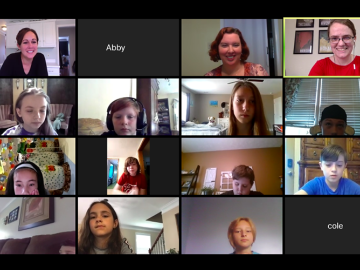
Filter News
Area of Research
- (-) Materials (55)
- (-) Nuclear Science and Technology (5)
- (-) Supercomputing (24)
- Advanced Manufacturing (10)
- Biology and Environment (9)
- Computer Science (2)
- Energy Science (64)
- Fusion and Fission (1)
- Fusion Energy (2)
- Materials for Computing (5)
- National Security (9)
- Neutron Science (19)
- Quantum information Science (1)
- Transportation Systems (1)
News Topics
- (-) 3-D Printing/Advanced Manufacturing (13)
- (-) Coronavirus (8)
- (-) Grid (3)
- (-) Materials Science (49)
- (-) Security (2)
- (-) Transportation (10)
- Advanced Reactors (12)
- Artificial Intelligence (11)
- Big Data (12)
- Bioenergy (8)
- Biology (1)
- Biomedical (11)
- Chemical Sciences (2)
- Clean Water (2)
- Composites (1)
- Computer Science (53)
- Critical Materials (2)
- Cybersecurity (4)
- Energy Storage (13)
- Environment (14)
- Exascale Computing (4)
- Frontier (3)
- Fusion (10)
- High-Performance Computing (2)
- Isotopes (5)
- Machine Learning (4)
- Materials (2)
- Mathematics (1)
- Microscopy (10)
- Molten Salt (3)
- Nanotechnology (19)
- National Security (1)
- Neutron Science (22)
- Nuclear Energy (36)
- Physics (11)
- Polymers (6)
- Quantum Science (15)
- Space Exploration (6)
- Summit (22)
Media Contacts

Scientists at the Department of Energy Manufacturing Demonstration Facility at ORNL have their eyes on the prize: the Transformational Challenge Reactor, or TCR, a microreactor built using 3D printing and other new approaches that will be up and running by 2023.

Research by an international team led by Duke University and the Department of Energy’s Oak Ridge National Laboratory scientists could speed the way to safer rechargeable batteries for consumer electronics such as laptops and cellphones.

Scientists have tapped the immense power of the Summit supercomputer at Oak Ridge National Laboratory to comb through millions of medical journal articles to identify potential vaccines, drugs and effective measures that could suppress or stop the

Oak Ridge National Laboratory researchers have developed a thin film, highly conductive solid-state electrolyte made of a polymer and ceramic-based composite for lithium metal batteries.

For the second year in a row, a team from the Department of Energy’s Oak Ridge and Los Alamos national laboratories led a demonstration hosted by EPB, a community-based utility and telecommunications company serving Chattanooga, Tennessee.

Researchers at the Department of Energy’s Oak Ridge National Laboratory are refining their design of a 3D-printed nuclear reactor core, scaling up the additive manufacturing process necessary to build it, and developing methods

With Tennessee schools online for the rest of the school year, researchers at ORNL are making remote learning more engaging by “Zooming” into virtual classrooms to tell students about their science and their work at a national laboratory.

In the race to identify solutions to the COVID-19 pandemic, researchers at the Department of Energy’s Oak Ridge National Laboratory are joining the fight by applying expertise in computational science, advanced manufacturing, data science and neutron science.

Scientists at Oak Ridge National Laboratory used a focused beam of electrons to stitch platinum-silicon molecules into graphene, marking the first deliberate insertion of artificial molecules into a graphene host matrix.

OAK RIDGE, Tenn., Feb. 27, 2020 — Researchers at Oak Ridge National Laboratory and the University of Tennessee achieved a rare look at the inner workings of polymer self-assembly at an oil-water interface to advance materials for neuromorphic computing and bio-inspired technologies.


